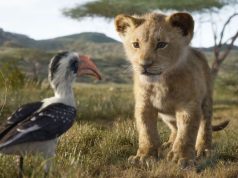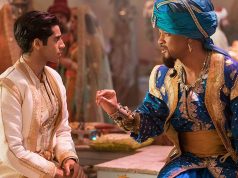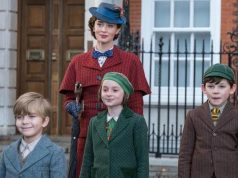It’s ironic that “The Chronicles of Narnia: The Lion, the Witch and the Wardrobe” could brim with religious allegory, yet turn out to be just as soulless as its secular blockbuster counterparts. It’s gorgeous and amazing, sure — every penny of the $150 million they spent on this thing is there on the screen — but money can’t buy emotional connection, and that’s what it needs so badly.
Based on the first volume in C.S. Lewis’ acclaimed series of fantasy novels, “The Lion, the Witch and the Wardrobe” is about four children who find that the wardrobe in the countryside mansion they’re staying in is a portal to another land. The land is Narnia, and it has recently been in a state of everlasting winter — always winter but never Christmas, we’re told — due to the evil influence of the White Witch (Tilda Swinton), an ice-cold despot who has claimed unrighteous dominion over the land and turns to stone all who oppose her.
The first child to discover Narnia is little Lucy (Georgie Henley), who befriends a polite faun named Mr. Tumnus (James McAvoy). Lucy’s brother, a disobedient scowler named Edmund (Skandar Keynes), wanders into Narnia next and is enchanted by the White Witch, who promises him all manner of treats if he will do her the simple favor of bringing himself and his three siblings to her castle when next he returns. (So she can kill them. But she doesn’t tell him that.)
Their older siblings, Peter (William Moseley) and Susan (Anna Popplewell), function as the family’s parents while their father is fighting World War II and their mother is back in London enduring the Blitz. They are skeptical of a foreign land being located in the back of a closet, but kindly old Professor Kirke (Jim Broadbent), whose mansion it is, helps them see the wisdom in believing what Lucy has to tell them.
At any rate, all four are soon in Narnia, where a friendly pair of beavers (voices of Ray Winstone and Dawn French) fill them (and us) in on Narnia’s history. There’s all that business with the White Witch, sure, but there’s also the matter of Aslan, a righteous lion who is expected to arrive soon, dethrone the witch, and restore order and balance to Narnia.
Upon the first mention of Aslan’s name, the camera pans across the faces of the four children, all with beatific looks, like neophytes hearing about the miracles of Jesus for the first time. Why, just the NAME “Aslan” sounds magnificent to them.
Except for Edmund, that is. While Peter the good son is the very model of angelic Aryan wholesomeness — fair skin, light hair, blue eyes — Edmund the bad son has darker features and freckles. He is unimpressed when he hears of Aslan. His loyalties lie with the White Witch.
It eventually befalls all four to aid the creatures of Narnia — which include regular animals and mythical beasts like centaurs — in their fight against the White Witch’s armies. Aslan does arrive, of course, with the calming voice of Liam Neeson, and a series of events ensues that will seem familiar in its basic outline to all who have studied the New Testament.
The film was directed by Andrew Adamson, who has made an impressive jump from the computer-animated “Shrek” films to “Narnia,” which is a mix of live action and realistic-looking computer animation. (You can barely tell that Aslan is not, in fact, a real talking lion.) The screenplay adaptation is credited to Adamson and three others, and it is mostly faithful to Lewis’ book. (One interesting mistake: Edmund tells the White Witch that the beavers “said something about the Stone Table,” which is true — except that the beavers mentioned it after Edmund had already left. In the book, he was still present for that conversation.)
But the film fails to bring with it any emotional significance. Some of the action is exciting, but I never had the sensation of actually CARING about the people involved. Part of the problem is that the main characters are played by children, who are notoriously hard to get heartfelt performances from. It doesn’t help that Peter is painted as blandly saintly, Edmund is generically misguided, and Susan barely registers at all. Only Lucy elicits a response, and even that is just the “aww, how adorable!” you feel for ANY cute kid in a movie.
The film is over two hours, and most of that is devoted to plot. There are no scenes where the characters stop and reflect on their plight or their mission so far, and that’s a shame. In the “Lord of the Rings” films (to cite something similar to “Narnia”), those were the segments that helped bond the characters to each other, and us to them, thus giving the whole affair some weight and depth.
Rather awkwardly, the movie lurches to its finale, set on a battlefield where Peter and the White Witch clumsily swing swords that are obviously too heavy for them. (Realistic, I suppose, given her dainty frame and his inexperience with warfare, but kind of funny to watch.) Next thing you know, the kids are adults, and then they leave the wardrobe and they’re kids again, and it all makes sense in the book, but in the movie, what the H?
Also what the H: Santa Claus shows up? And gives everybody weapons?!
It may be possible to create a film version of “Narnia” worthy of the book’s reputation and belovedness. But this one isn’t it. This comes off as an uninspired fantasy bonanza, no more compelling than your average episode of “Xena: Warrior Princess.”
NOTE: “The Lion, the Witch and the Wardrobe” is indeed the first book in the “Chronicles of Narnia” series, in that it was written and published before the others. There are others in the series that take place before “The Lion, the Witch and the Wardrobe,” but “Lion” still came first. So to the people who keep e-mailing me to tell me I am mistaken when I call “Lion” the first book in the series: Stop. I do make mistakes, but this isn’t one of them.
C (2 hrs., 20 min.; )





